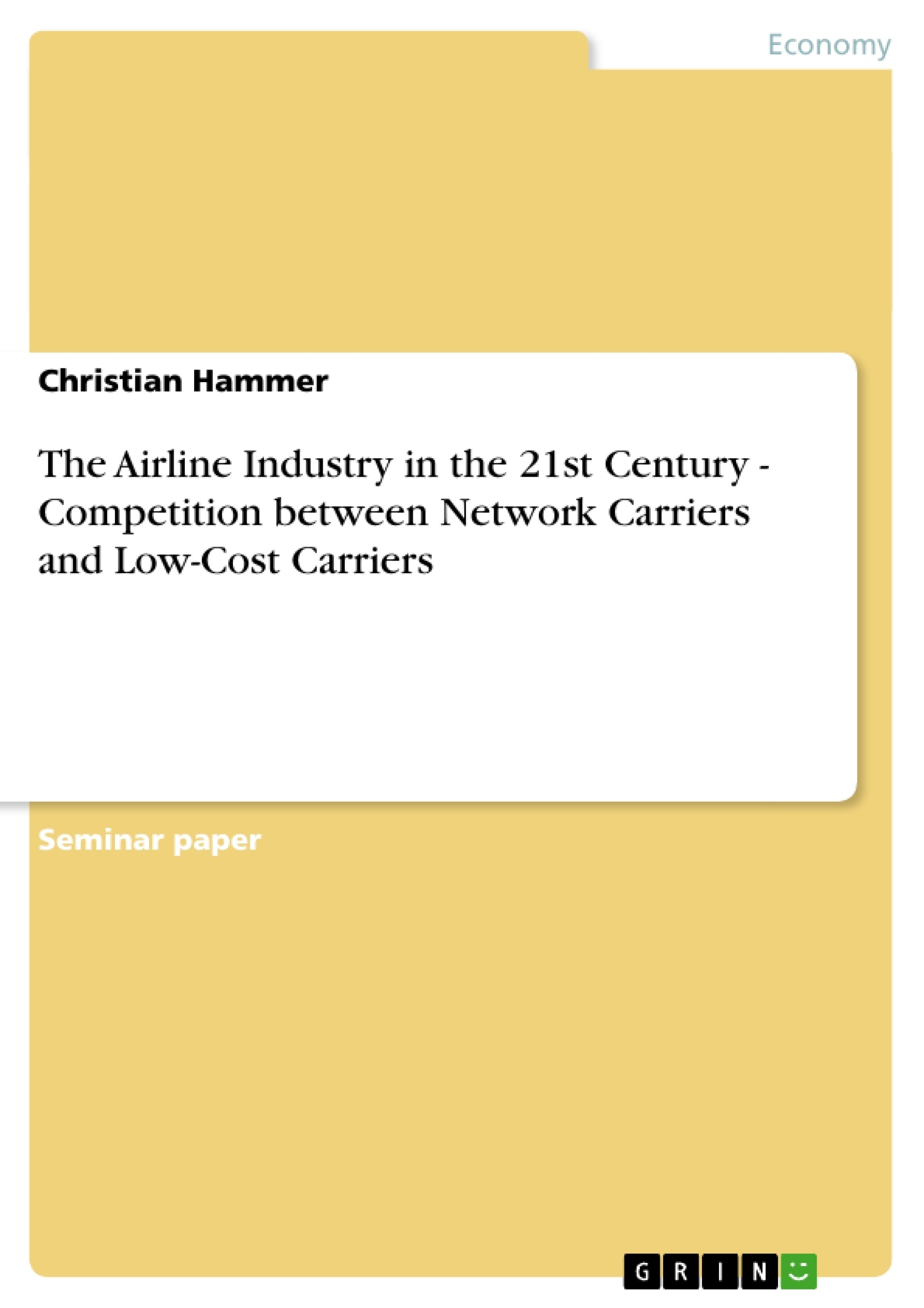External shocks, such as terrorist attacks, wars in Afghanistan and Iraq, the SARS epidemic and the worldwide economic downturn have hit the aviation industry badly. Many airlines have posted substantial losses (Lindstädt and Fauser 2003, 23). According to the chairman of Lufthansa’s supervisory board, Jürgen Weber (“Fliegen, bis der Geier kommt”: 58), about half of the [network] airlines are de facto bankrupt. Franke (2004: 15) argues that “the severe crisis of the global aviation industry has primarily struck the classical network carriers (NCs) with their complex hub&spoke [sic!] operation platforms”. Low-cost carriers (LCCs), however, were not hit by the downturn. With their lean business models they offered a good alternative at a time when passengers began to look for ways to avoid paying the high prices NCs demanded (Franke 2004:15).
This paper analyses the competitive environment in the airline industry. I shall briefly describe the different business models in the industry: the LCC and the NC model. I will then analyze the role airports play. The main purpose however, is to identify possible future scenarios in the industry.
Inhaltsverzeichnis (Table of Contents)
- Introduction
- Business models
- The LCC business model
- The LCC business model of Southwest Airlines
- The LCC business model of Ryanair
- The NC business model
- The role of airports
- Airport requirements of LCCs
- The airport's point of view
- Outlook on the future
- Is the network airline business model broken?
- Future of the LCC model
- Conclusion
Zielsetzung und Themenschwerpunkte (Objectives and Key Themes)
This paper examines the competitive environment within the airline industry, focusing on the contrasting business models of low-cost carriers (LCCs) and network carriers (NCs). The primary goal is to identify potential future scenarios within the industry, considering the impact of external factors and the evolution of both LCC and NC models.
- The rise of low-cost carriers (LCCs) and their impact on the traditional network carrier (NC) model.
- The cost-saving strategies employed by LCCs, including lean production, point-to-point services, and fleet optimization.
- The role of airports in facilitating both LCC and NC operations, considering their specific requirements and perspectives.
- The potential future scenarios in the airline industry, analyzing the sustainability of both LCC and NC models.
- The influence of external factors such as economic downturns, terrorist attacks, and global pandemics on the airline industry.
Zusammenfassung der Kapitel (Chapter Summaries)
- Introduction: This chapter introduces the paper's focus on the competitive dynamics within the airline industry, highlighting the significant impact of external shocks on the industry and the contrasting responses of network carriers (NCs) and low-cost carriers (LCCs).
- Business models: This chapter examines the distinct business models of LCCs and NCs, emphasizing the cost advantages of LCCs and exploring various approaches to explaining the cost differentials between the two models.
- The LCC business model: This chapter delves into the LCC model, focusing on its core principles and how it differs from the NC model. It highlights the success of Southwest Airlines as a pioneer in the LCC space and analyzes its operational effectiveness and unique features.
- The LCC business model of Southwest Airlines: This section examines the operational model of Southwest Airlines, emphasizing its commitment to lean production, high-frequency flights, and a focus on employee engagement. It highlights the company's success and the key factors contributing to its competitive advantage.
- The LCC business model of Ryanair: This section explores Ryanair's approach to LCC operations, emphasizing its aggressive cost reduction strategies and unique revenue generation methods. It discusses the benefits and drawbacks of outsourcing in this context.
- The role of airports: This chapter analyzes the relationship between airports and airlines, focusing on the specific requirements of LCCs and the perspectives of airport management.
- Airport requirements of LCCs: This section explores the airport infrastructure and facilities necessary to support LCC operations, considering factors such as landing fees and ground handling services.
- The airport's point of view: This section examines the airport's perspective on LCCs, considering the economic benefits and potential challenges associated with their presence.
- Outlook on the future: This chapter explores potential future scenarios in the airline industry, examining the sustainability of the NC model and the future prospects of LCCs.
- Is the network airline business model broken?: This section analyzes the challenges faced by traditional NCs and discusses potential threats to their long-term viability in a competitive market.
- Future of the LCC model: This section explores the future of LCCs, considering their potential for continued growth and expansion in the airline industry.
Schlüsselwörter (Keywords)
The primary keywords and focus topics include: low-cost carriers (LCCs), network carriers (NCs), business models, cost differentials, lean production, point-to-point services, hub-and-spoke networks, airport requirements, airline competition, future scenarios, and external shocks.
- Quote paper
- Christian Hammer (Author), 2005, The Airline Industry in the 21st Century - Competition between Network Carriers and Low-Cost Carriers, Munich, GRIN Verlag, https://www.grin.com/document/61822



